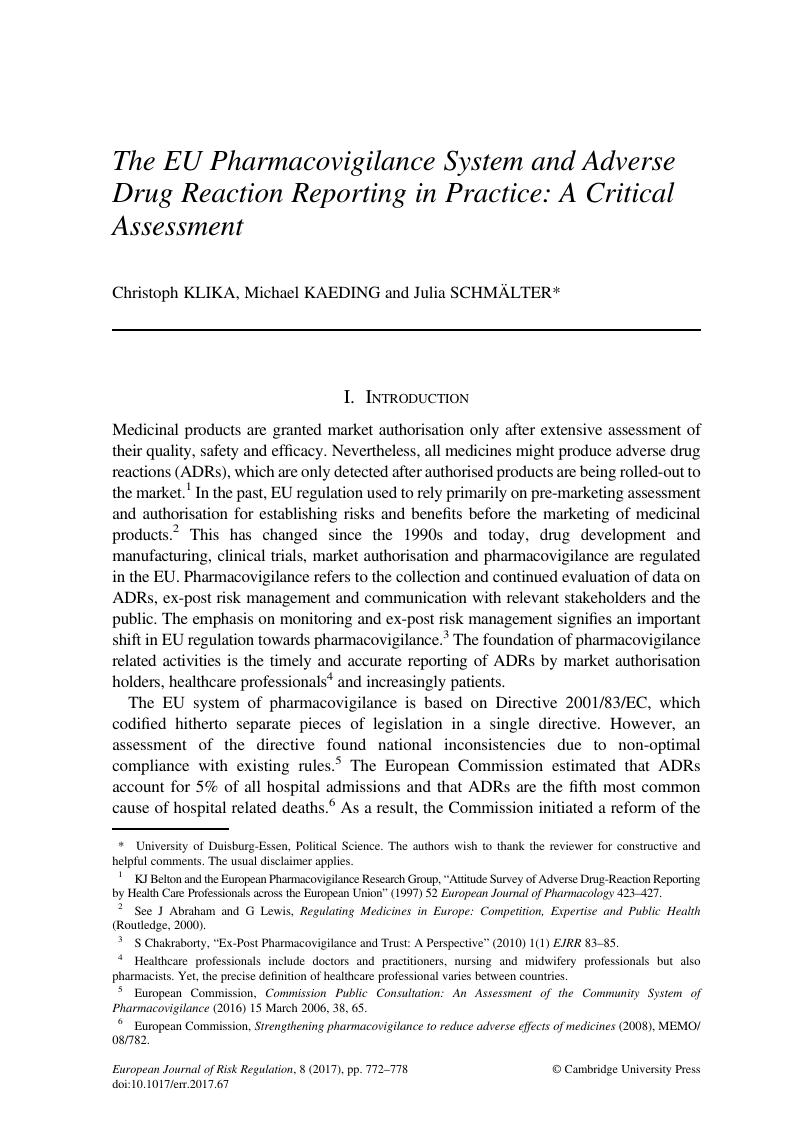No CrossRef data available.
Article contents
The EU Pharmacovigilance System and Adverse Drug Reaction Reporting in Practice: A Critical Assessment
Published online by Cambridge University Press: 06 December 2017
Abstract

- Type
- Reports
- Information
- European Journal of Risk Regulation , Volume 8 , Special Issue 4: Special Issue on the EU Public-Health-Security Nexus , December 2017 , pp. 772 - 778
- Copyright
- © Cambridge University Press
Footnotes
University of Duisburg-Essen, Political Science. The authors wish to thank the reviewer for constructive and helpful comments. The usual disclaimer applies.
References
1 Belton, KJ the European Pharmacovigilance Research Group, “Attitude Survey of Adverse Drug-Reaction Reporting by Health Care Professionals across the European Union” (1997) 52 European Journal of Pharmacology 423–427 Google ScholarPubMed.
2 See Abraham, J and Lewis, G, Regulating Medicines in Europe: Competition, Expertise and Public Health (Routledge, 2000)Google Scholar.
3 Chakraborty, S, “Ex-Post Pharmacovigilance and Trust: A Perspective” (2010) 1(1) EJRR 83–85 Google Scholar.
4 Healthcare professionals include doctors and practitioners, nursing and midwifery professionals but also pharmacists. Yet, the precise definition of healthcare professional varies between countries.
5 European Commission, Commission Public Consultation: An Assessment of the Community System of Pharmacovigilance (2016) 15 March 2006, 38, 65.
6 European Commission, Strengthening pharmacovigilance to reduce adverse effects of medicines (2008), MEMO/08/782.
7 Directive 2010/84/EU of the European Parliament and of the Council of 15 December 2010 amending, as regards pharmacovigilance, Directive 2001/83/EC on the Community code relating to medicinal products for human use, (2010) OJ L348/74.
8 In addition, the reform introduced a wider definition of adverse drug reactions including medication errors and overdose. It also brought about the so-called “black triangle”, which marks medicines subject to additional monitoring. The instrument of post-authorisation safety studies as part of the pre-market authorisation was strengthened and a Pharmacovigilance Risk Assessment Committee (PRAC) was set up within EMA.
9 European Commission, Commission Staff Working Document Accompanying the document Commission Report Pharmacovigilance related activities of Member States and the European Medicines Agency concerning medicinal products for human use (2012 – 2014), (2016) SWD(2016) 284 final, 8 August 2016; also for a positive assessment of the system see JJ Borg et al., “European Union pharmacovigilance capabilities: potential for the new legislation” (2015) 6(4) Therapeutic Advances in Drug Safety 120–140.
10 The article is based on a research project analysing the practical implementation of EU pharmacovigilance legislation (Directive 2010/84/EU); see Kaeding, M, Schmälter, J and Klika, C, Pharmacovigilance in the European Union: Practical Implementation across Member States (Springer, 2017)CrossRefGoogle Scholar <http://www.springer.com/de/book/9783658172756> accessed 19 May 2017.
11 Council of the European Union, Note from: General Secretariat of the Council to: Working Party on Pharmaceuticals and Medical Devices, (2009) 7996/1/09 4 May 2009.
12 Art 102(a) Directive 2010/84/EU, supra, note 7.
13 Art 102(b) ibid.
14 Chakraborty, supra, note 3.
15 European Commission, supra, note 9.
16 Health Action International, Direct Patient Reporting in the European Union: A Snapshot of Reporting Systems in Seven Member States, (2015) available at <haieurope.org/wp-content/uploads/2015/09/Direct-Patient-Reporting-in-the-EU.pdf>, accessed 16 February 2017.
17 European Commission, supra, note 9.
18 Sloane, R et al., “Social media and pharmacovigilance: A review of the opportunities and challenges” (2015) 80(4) British Journal of Clinical Pharmacology 910–920 CrossRefGoogle ScholarPubMed.
19 VM Šarinić et al., Topic 1 Audit of National Reporting Systems, Topic 1a Medication Errors, Topic 2 Patient Reporting, Topic 5 Review of IT Systems and Special Form of Reports (SCOPE Work Package 4 Survey Report 2016) p 10.
20 Health Action International, supra, note 16.
21 Art 101(1) Directive 2010/84/EU, supra, note 7.
22 European Parliament, Report on the proposal for a directive of the European Parliament and of the Council amending, as regards pharmacovigilance, Directive 2001/83/EC on the Community code relating to medicinal products for human use, (2010) A7-0159/2010 2 June 2010.
23 Šarinić et al., supra, note 19.
24 See Art 102(e) Directive 2010/84/EU, supra, note 7; Member States shall “ensure … that all appropriate measures are taken to identify clearly any biological medicinal product prescribed, dispensed or sold in their territory which is the subject of a suspected adverse reaction report”. Biologicals have distinctive features that can cause ADRs and might not be detectable in conventional clinical trials. Furthermore, biologicals pose a specific challenge to pharmacovigilance because they are developed in long and complex production processes, whereby minor changes in any step of the manufacturing process can affect the product quality and safety. Therefore, it is crucial that not only the brand name, but also the batch number is accurately reported, given that changes might affect batches within the same medicinal product; see Calvo, B and Zuňiga, L, “EU’s New Pharmacovigilance Legislation: Considerations for Biosimilars” (2014) 37 Drug Safety 9–18 CrossRefGoogle ScholarPubMed.
25 Douros, A et al., “Pharmakovigilanz in Deutschland” (2016) 57 Internist 616–623 CrossRefGoogle Scholar.
26 Council of Europe, The ever-growing challenge of medical liability: national and European responses. Conference, Strasbourg, 2-3 June 2008. Proceedings, (2009), available at <www.coe.int/t/dghl/standardsetting/cdcj/CJSMED/conf_ml_2008.pdf>, accessed 16 February 2017.
27 European Commission, “Commission Staff Working Document”; Borg et al., supra, note 9.
28 We are indebted to the reviewer for drawing our attention to this comparative perspective.
29 Kapur, N et al., “Aviation and healthcare: a comparative review with implications for patient safety” (2016) JRSM Open 7(1)CrossRefGoogle ScholarPubMed. On the implementation of aviation safety across Europe, see also Groenleer, M, Kaeding, M and Versluis, E “Regulatory governance through agencies of the European Union? The role of the European agencies for maritime and aviation safety in the implementation of European transport legislation” (2010) 17(8) Journal of European Public Policy 1212–1230 CrossRefGoogle Scholar.


